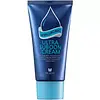What's inside
What's inside
 Key Ingredients
Key Ingredients

 Benefits
Benefits

 Concerns
Concerns

No concerns
 Ingredients Side-by-side
Ingredients Side-by-side

Water
Skin ConditioningSqualane
EmollientGlycerin
HumectantPentylene Glycol
Skin ConditioningPolyglyceryl-2 Stearate
EmulsifyingGlyceryl Stearate
EmollientStearyl Alcohol
EmollientHyaluronic Acid
HumectantCeramide EOP
Skin ConditioningCeramide Ng
Skin ConditioningCeramide NP
Skin ConditioningCeramide As
Skin ConditioningCeramide AP
Skin ConditioningCarnosine
Skin ConditioningHydrogenated Lecithin
EmulsifyingPhytosterols
Skin ConditioningCaprylyl Glycol
EmollientPolyacrylate Crosspolymer-11
Emulsion Stabilising1,2-Hexanediol
Skin ConditioningWater
Skin ConditioningButylene Glycol
HumectantCyclopentasiloxane
EmollientGlycerin
HumectantDimethicone
EmollientBis-PEG-15 Methyl Ether Dimethicone
EmulsifyingTriethylhexanoin
MaskingNeopentyl Glycol Diheptanoate
EmollientCetearyl Alcohol
Emollient1,2-Hexanediol
Skin ConditioningGlyceryl Stearate
EmollientOlea Europaea Fruit Oil
MaskingHelianthus Annuus Seed Oil
EmollientPEG-100 Stearate
Panthenol
Skin ConditioningCyclohexasiloxane
EmollientCarbomer
Emulsion StabilisingTromethamine
BufferingDimethicone/Vinyl Dimethicone Crosspolymer
Skin ConditioningPolysorbate 20
EmulsifyingSodium Hyaluronate
HumectantCetearyl Glucoside
EmulsifyingBetula Platyphylla Japonica Juice
Skin ConditioningDipotassium Glycyrrhizate
HumectantTranexamic Acid
AstringentEthylhexylglycerin
Skin ConditioningAdenosine
Skin ConditioningAlcohol
AntimicrobialDisodium EDTA
Caprylic/Capric Triglyceride
MaskingCeramide NP
Skin ConditioningGentiana Lutea Root Extract
Skin ConditioningAchillea Millefolium Extract
CleansingArtemisia Absinthium Extract
Skin ConditioningArnica Montana Flower Extract
MaskingBambusa Vulgaris Leaf Extract
Skin ConditioningGlucose
HumectantIris Florentina Root Extract
MaskingPropylene Glycol
HumectantTocopherol
AntioxidantCitric Acid
BufferingGlycine
BufferingPotassium Sorbate
PreservativeSerine
MaskingGlutamic Acid
HumectantBiosaccharide Gum-2
Skin ConditioningAspartic Acid
MaskingLeucine
Skin ConditioningAlanine
MaskingLysine
Skin ConditioningArginine
MaskingTyrosine
MaskingPhenylalanine
MaskingValine
MaskingThreonine
Proline
Skin ConditioningIsoleucine
Skin ConditioningHistidine
HumectantMethionine
Skin ConditioningCysteine
AntioxidantWater, Butylene Glycol, Cyclopentasiloxane, Glycerin, Dimethicone, Bis-PEG-15 Methyl Ether Dimethicone, Triethylhexanoin, Neopentyl Glycol Diheptanoate, Cetearyl Alcohol, 1,2-Hexanediol, Glyceryl Stearate, Olea Europaea Fruit Oil, Helianthus Annuus Seed Oil, PEG-100 Stearate, Panthenol, Cyclohexasiloxane, Carbomer, Tromethamine, Dimethicone/Vinyl Dimethicone Crosspolymer, Polysorbate 20, Sodium Hyaluronate, Cetearyl Glucoside, Betula Platyphylla Japonica Juice, Dipotassium Glycyrrhizate, Tranexamic Acid, Ethylhexylglycerin, Adenosine, Alcohol, Disodium EDTA, Caprylic/Capric Triglyceride, Ceramide NP, Gentiana Lutea Root Extract, Achillea Millefolium Extract, Artemisia Absinthium Extract, Arnica Montana Flower Extract, Bambusa Vulgaris Leaf Extract, Glucose, Iris Florentina Root Extract, Propylene Glycol, Tocopherol, Citric Acid, Glycine, Potassium Sorbate, Serine, Glutamic Acid, Biosaccharide Gum-2, Aspartic Acid, Leucine, Alanine, Lysine, Arginine, Tyrosine, Phenylalanine, Valine, Threonine, Proline, Isoleucine, Histidine, Methionine, Cysteine
 Reviews
Reviews

Ingredients Explained
These ingredients are found in both products.
Ingredients higher up in an ingredient list are typically present in a larger amount.
1,2-Hexanediol is a synthetic liquid and another multi-functional powerhouse.
It is a:
- Humectant, drawing moisture into the skin
- Emollient, helping to soften skin
- Solvent, dispersing and stabilizing formulas
- Preservative booster, enhancing the antimicrobial activity of other preservatives
Ceramide NP is a type of ceramide and formally known as ceramide 3.
Ceramides are intercellular lipids naturally found in our skin that bonds dead skin cells together to create a barrier. They are known for their ability to hold water and thus are a great ingredient for dry skin.
Ceramides are an important building block for our skin barrier. A stronger barrier helps the skin look more firm and hydrated. By bolstering the skin ceramides act as a barrier against irritating ingredients. This can help with inflammation as well.
If you would like to eat ceramides, sweet potatoes contain a small amount.
Read more about other common types of ceramides here:
Ceramide AP
Ceramide EOP
Glycerin is already naturally found in your skin. It helps moisturize and protect your skin.
A study from 2016 found glycerin to be more effective as a humectant than AHAs and hyaluronic acid.
As a humectant, it helps the skin stay hydrated by pulling moisture to your skin. The low molecular weight of glycerin allows it to pull moisture into the deeper layers of your skin.
Hydrated skin improves your skin barrier; Your skin barrier helps protect against irritants and bacteria.
Glycerin has also been found to have antimicrobial and antiviral properties. Due to these properties, glycerin is often used in wound and burn treatments.
In cosmetics, glycerin is usually derived from plants such as soybean or palm. However, it can also be sourced from animals, such as tallow or animal fat.
This ingredient is organic, colorless, odorless, and non-toxic.
Glycerin is the name for this ingredient in American English. British English uses Glycerol/Glycerine.
Learn more about GlycerinGlyceryl Stearate is a mix of glycerin and stearic acid.
It is used to stabilize the mixing of water and oil ingredients. By preventing these ingredients from separating, it can help elongate shelf life. It can also help thicken the product's texture.
As an emollient, it helps soften skin and supports barrier-replenishing ingredients.
In cosmetics, Glyceryl Stearate is often made from vegetable oils or synthetically produced.
This ingredient may not be fungal-acne safe
Fun fact: The human body also creates Glyceryl Stearate naturally.
Learn more about Glyceryl StearateWater. It's the most common cosmetic ingredient of all. You'll usually see it at the top of ingredient lists, meaning that it makes up the largest part of the product.
So why is it so popular? Water most often acts as a solvent - this means that it helps dissolve other ingredients into the formulation.
You'll also recognize water as that liquid we all need to stay alive. If you see this, drink a glass of water. Stay hydrated!
Learn more about Water